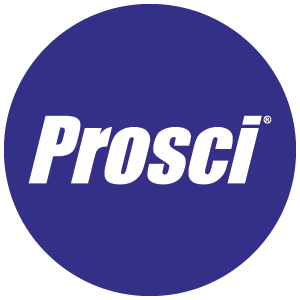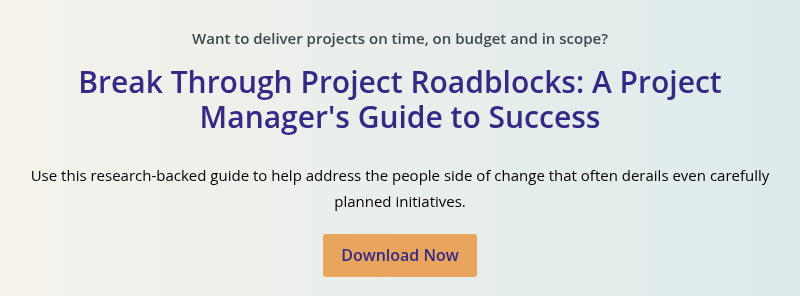Boost Your Project Management Process With Change Management

8 Mins
Updated: April 11, 2025
Published: February 3, 2025

Most organizations invest heavily in project management processes, yet many projects still fail to deliver lasting results. Even when projects are completed on time and within budget, they often fall short because people struggle to adopt the changes they bring.
Project management processes lay the foundation for execution, but without adoption, even the most well-planned initiatives fall flat. Success isn’t just about delivering a project—it’s about ensuring people embrace, adopt and sustain the change it brings.
For this reason, change management is essential. It acts as the force that drives transformation, accelerates results, and turns project investments into lasting business impact.
This article explores the five key phases of project management processes, common challenges, and critical project deliverables while demonstrating how Prosci’s proven change management methodology maximizes project success.
What Is the Project Management Process?
According to the Project Management Institute, project management is “the application of knowledge, skills, tools and techniques to project activities to meet project requirements.”
Project management provides a structured approach to planning, executing and controlling projects to achieve specific business goals. It focuses on key objectives, including task efficiency, risk mitigation, cost control, quality assurance and stakeholder alignment.
Providing the guardrails that guide a project from conception to completion, project management helps turn business ideas into successful outcomes that achieve lasting impact.
Why project execution alone doesn’t ensure success
Project management aligns with the traditional measures of project success—project completion on time, on budget and within the specified scope. However, these metrics alone are not enough to determine whether a project delivers real business value.
A successful project depends on more than just execution; it’s defined by whether people adopt and adapt to the change it brings. A study by Boston Consulting Group found that 50% of change initiatives fail to meet their goals, often because organizations underestimate the importance of addressing the human side of change.
Prosci’s own research highlights the importance of integrating project management processes with people-centric change management. In a study on Best Practices in Change Management, 88% of participants with excellent change management programs in place were able to meet or exceed project objectives. Clearly, without a structured change management approach, even the most well-planned projects risk falling short of their potential.
How change management and project management align
Project management provides the structure to plan, execute and monitor projects. Change management drives meaningful impact by ensuring employees adopt the change a project brings. Both disciplines are necessary when planning and executing a project—and they must work together to facilitate successful and lasting change.
By embedding change management at every phase of the project lifecycle, you can support your employees through change, accelerate adoption and maximize project impact.
Bringing together project management and change management creates a Unified Value Proposition. This provides a framework for tactical integration and ensures both the technical execution and people-focused aspects of the project deliver meaningful value.
Unified Value Proposition

Integrating Change Management With Project Management
As we’ve established, project management and change management are best viewed as complementary disciplines that work together to improve the likelihood of project success. The question is, how do you effectively integrate change management into your project management approach?
A change management approach like the Prosci Methodology seamlessly aligns with standard project management practices. It embeds structured communication, training and reinforcement from planning through to sustainment.
Here’s a quick look at how you can apply the Prosci Methodology to support and enhance project management:
The Prosci Change Triangle (PCT) Model provides a comprehensive framework that integrates change management principles into the project lifecycle.
By focusing on four key aspects—success, leadership, project management and change management—project managers can enhance their ability to deliver successful change initiatives.
The Prosci ADKAR® Model represents the five elements individuals must have to successfully navigate transitions. It offers a structured, people-centric approach to change. Helping people adopt change requires more than effective communication.
By supporting individual transitions, aligning change management activities with project milestones, and removing barriers to change, this integration leads to improved adoption and use of changes within your organization.
Prosci ADKAR Model

The Prosci 3-Phase Process supports project management activities across three phases:
- Phase 1 – Prepare Approach – Establishes clear objectives, stakeholder alignment, and strategic planning, ensuring project managers have a well-defined roadmap for implementation.
- Phase 2 – Manage Change – Integrates structured planning, progress tracking, and adaptive execution, helping project managers address challenges, optimize performance, and keep projects on track.
- Phase 3 – Sustain Outcomes – Ensures long-term adoption, performance evaluation, and ownership transfer, allowing project managers to secure lasting results and maximize project impact.
Prosci 3-Phase Process

Once you understand how change management aligns with broader project principles, the next step is to see how it fits into the overall project lifecycle. Let’s take a closer look at how change management can be applied across each of the five key phases of project management.
Applying Change Management to the 5 Phases of the Project Management Process
Every project moves through five key phases: initiation, planning, execution, monitoring and controlling, and closure. Embedding change management principles into each of these phases increases the likelihood that a project will achieve its objectives and deliver sustained change.
In this section, we’ll explore what each of these five phases involves and how you can integrate the Prosci ADKAR Model, integral to the Prosci Methodology, into the project management phase.

1. Project initiation
This phase lays the foundation for project success by defining objectives, scope and stakeholder involvement. It includes conducting business case analysis and feasibility studies, as well as establishing key deliverables such as the project charter and stakeholder register. Without proper initiation, projects risk scope creep, misalignment and wasted resources.
At this stage, our ADKAR Model begins by building Awareness and Desire:
- Create Awareness – Clearly communicate why the change is happening, along with its objectives and impacts, to ensure all those impacted are aligned from the start.
- Build Desire – Engage the people impacted by the change early by highlighting the benefits of the change and addressing concerns. This fosters commitment and support for successful adoption.
2. Project planning
The planning phase turns project vision into a structured roadmap, ensuring clear timelines, budgets and risk management to prevent costly delays. Key deliverables, such as the project management plan, risk register and communications plan, set the stage for successful execution.
During the planning phase, the ADKAR Model focuses on building Knowledge and Ability:
- Develop Knowledge – Define people’s engagement, communications plans and potential concerns early. This ensures employees understand the change, its purpose, and their role in the transition.
- Enable Ability – Provide the necessary training, resources and support so individuals are equipped to adopt the change smoothly when the project execution stage begins.
3. Project execution
The project execution phase is where plans turn into action—teams collaborate, manage workflows and produce deliverables.
Effective communication and collaboration tools keep projects aligned, while status reports, performance dashboards and team meetings provide visibility into progress. Managing unexpected challenges during the execution stage is critical to keeping projects on track and within scope.
During this phase, the ADKAR Model focuses on Ability and Reinforcement:
- Enable Ability – Provide training, support and hands-on resources to equip employees with the skills needed to adopt the change effectively.
- Reinforce Adoption – Establish feedback loops, recognition programs and ongoing support to reinforce new behaviors and sustain long-term success.
Here's a real-world example: During the project execution phase of an IT system upgrade project, the technical team handles deployment. On the people side, change managers ensure employees fully understand the new system, are prepared for the upcoming changes and have ongoing support to reinforce adoption.
4. Project monitoring and controlling
This phase ensures that projects stay on track, within budget and aligned with business goals. This is achieved by tracking KPIs, managing risks and controlling costs. Progress is monitored through deliverables like performance reports, risk management updates, and quality control logs.
Proactive oversight prevents minor issues from escalating into major setbacks during the monitoring and controlling stage.
At this stage, our ADKAR Model focuses on Reinforcement and Feedback:
- Reinforce Adoption – Continuously track adoption rates and proficiency levels, identifying areas where employees need additional support.
- Gather Feedback – Engage impacted people to collect insights on challenges and resistance, refining strategies to maintain long-term engagement and success.
5. Project closure
The closure phase finalizes project activities. It ensures a smooth transition to business operations. This includes documenting lessons learned, gathering feedback, and completing key documentation. Project closure documents can include the final project report, stakeholder satisfaction surveys, and post-mortem analysis.
With proper project closure, you can avoid repeating mistakes while maintaining the project outcomes.
The ADKAR Model focuses on Reinforcement to ensure that employees fully adopt and sustain the change. This can include conducting final assessments, reviewing adoption success and documenting lessons learned. These activities help you refine future change initiatives and reinforce ongoing success.
While embedding change management into each project phase builds a strong foundation, it’s just as important to address the challenges that can derail progress. In the next section, we’ll explore some of the most common project management pitfalls—and how you can address them through effective change management.

Common Project Management Challenges—and How Effective Change Management Can Help
Many common project challenges arise from misaligned expectations, poor communication, and inadequate planning for resources and risks. By integrating change management practices, you can proactively address these issues—ensuring clarity, alignment and smoother execution at every stage of the project.
Scope creep
A survey conducted by IEEE found that 92% of the respondents’ projects failed due to a lack of scope creep management. A key challenge in project management, scope creep often results from unclear requirements or evolving demands.
By integrating change management into the project management process, you can effectively manage change while keeping scope creep at bay.
The Prosci 3-Phase Process helps prevent scope creep at every stage. Phase 1 – Prepare Approach defines success, impact and resource needs to avoid unplanned changes. Phase 2 – Manage Change uses structured plans and monitoring to control deviations. Finally, Phase 3 – Sustain Outcomes reinforces adoption and prevents unnecessary scope expansion.
Poor communication
A lack of clear communication during project planning and execution can create misalignment between teams, clients and stakeholders. This can lead to delays, misunderstandings and costly rework.
Effective communication plans and collaboration tools are crucial to ensuring everyone stays informed, aligned and focused on project objectives.
The Prosci 3-Phase Process emphasizes clarity, stakeholder engagement and proactive management. This process helps to address the issue of poor communication through:
- A structured communications plan that engages preferred senders at the right times with the right messages.
- Regular monitoring that allows messaging adjustments as needed.
- Ongoing reinforcement to ensure that communication remains effective beyond project completion.
Inefficient resource allocation
Poor resource allocation represents a significant challenge in project management that can lead to burnout, delays and underutilized talent. Ultimately, this can impact timeframes, budgets and productivity.
A structured approach to optimizing resources ensures that projects stay on track, teams remain engaged, and budgets are used effectively.
Change management plays a critical role in preventing inefficient resource allocation during a project by ensuring that resources are effectively aligned with project goals and stakeholder needs.
Lack of risk management
Failing to anticipate and mitigate risks leaves projects vulnerable to unexpected setbacks, cost overruns and delays. Without a robust risk management strategy, teams struggle to respond effectively, increasing the likelihood of project failure.
Proactively identifying risks ensures smoother execution, better resource management, and successful project outcomes.
Integrating change management into the project management approach can significantly enhance your ability to manage risks. For example, the PCT Assessment helps analyze key aspects of the project’s health, potentially uncovering previously hidden issues. By proactively addressing these issues, you can develop mitigation strategies that reduce the likelihood of project delays or failures.
Prosci Change Triangle (PCT) Model
%20Model_project%20management%20process.webp?width=527&height=373&name=Prosci%20Change%20Triangle%20(PCT)%20Model_project%20management%20process.webp)
Key Project Deliverables for Project Management Success
To deliver successful projects, you need to focus on a few key elements that ensure alignment, accountability, and measurable project outcomes.
Here are three key deliverables you can use to guide execution and drive project success from initiation to closure:
Clear and actionable project documentation
Well-defined project documentation such as risk registers and status reports ensures people alignment, providing clarity and consistency throughout the project lifecycle.
By keeping documentation centralized and regularly updated, you can prevent common project issues such as miscommunication, scope creep and inefficiencies while making it easier to track progress and manage risks.
Integrated change management can enhance the quality and utility of project documentation. It emphasizes clarity, stakeholder engagement, effective communication and continuous improvement. For example:
- Clearly defined objectives keep stakeholders aligned.
- Stakeholder input adds value to project documents.
- Strategic communication plans ensure project documentation remains relevant, actionable and adaptable.
Defined roles, responsibilities and accountability
Clearly defining who is responsible for decisions, approvals and task execution is essential for project success. When roles are well-structured, people collaborate more effectively, reducing confusion and delays.
Clarity prevents inefficiencies, strengthens stakeholder engagement and ensures leadership involvement, minimizing project roadblocks and driving smooth execution.
By assigning key roles such as sponsors, people managers and change practitioners early in the project lifecycle, change management helps foster ownership and accountability. In addition, ongoing performance assessments strengthen role clarity, ensuring all stakeholders contribute effectively to the project’s success.
Performance metrics and success indicators
Defining how success is measured ensures projects go beyond completion to deliver real impact. Traditional KPIs like budget, timeline and scope assess execution, while adoption-related metrics track how well new processes or tools are embraced.
Throughout the project management process, continuous monitoring and feedback loops help teams proactively address challenges before they escalate and optimize project outcomes.
Naturally, change management focuses on the people side of the success equation, measuring how well the workforce adopts and sustains change. The Prosci Methodology tracks progress at three levels:
- Organizational Performance – Assesses whether the change delivers business benefits through KPIs like productivity, cost savings and customer satisfaction.
- Individual Performance – Measures employee adoption and proficiency, tracking metrics like adoption speed, utilization and proficiency.
- Change Management Performance – Evaluates the effectiveness of change management efforts, including plan execution and stakeholder engagement.
Tracking progress across all three levels of performance is essential for measuring change success.
Improving Project Management With Effective Change Management
A project isn’t successful just because it’s delivered on time and on budget. Real success happens when the people involved adopt and sustain the change.
That’s why a people-centric approach is essential; one that prepares employees for change, supports them through the transition and ensures the project delivers a lasting impact.
Project management and change management need to collaborate to drive technical execution and human adoption, increasing success rates and long-term business impact.
By integrating a structured change management framework like the Prosci Methodology into the project management approach, you can support employees through resistance, accelerate change adoption and ensure lasting value from your projects.




